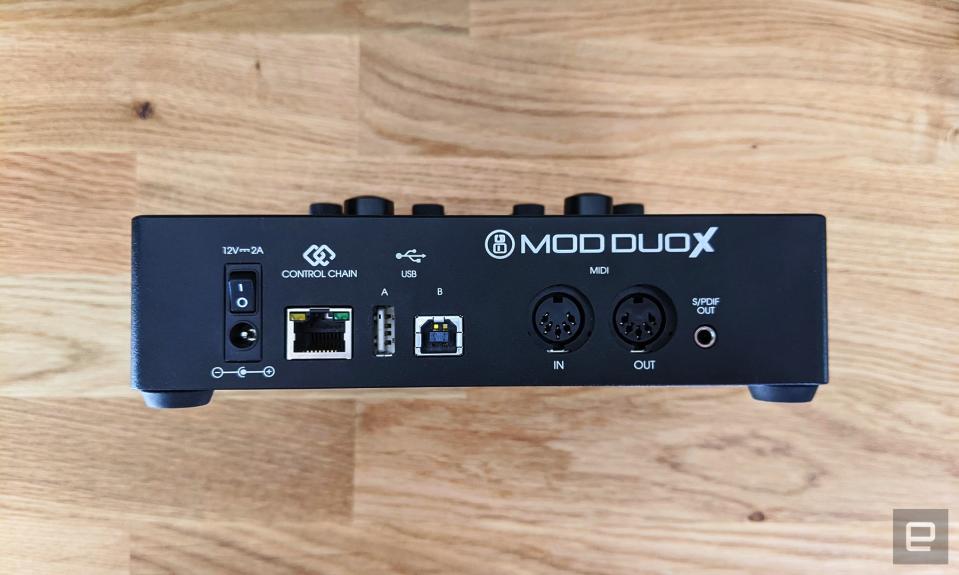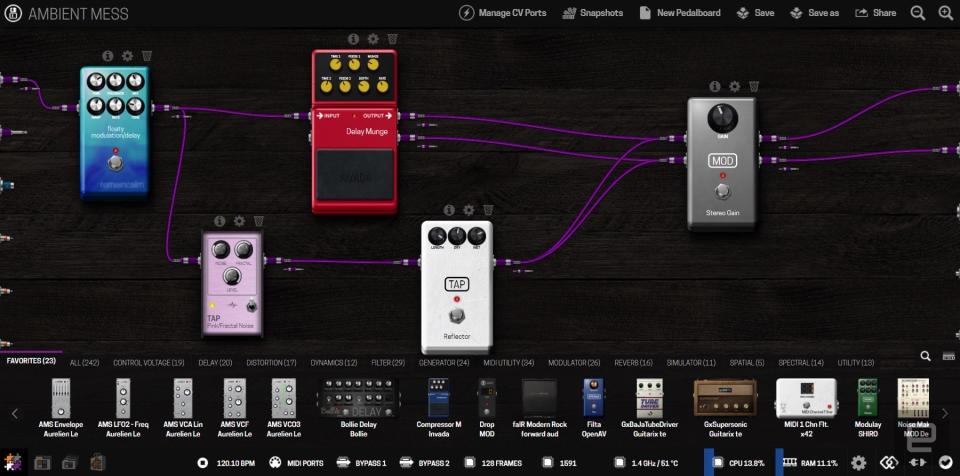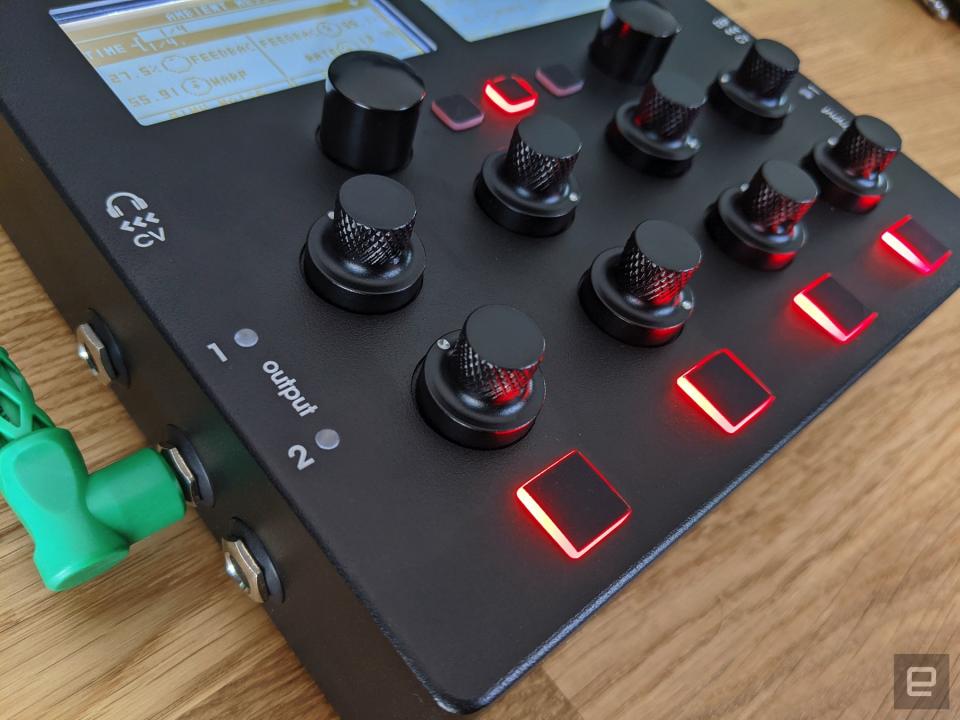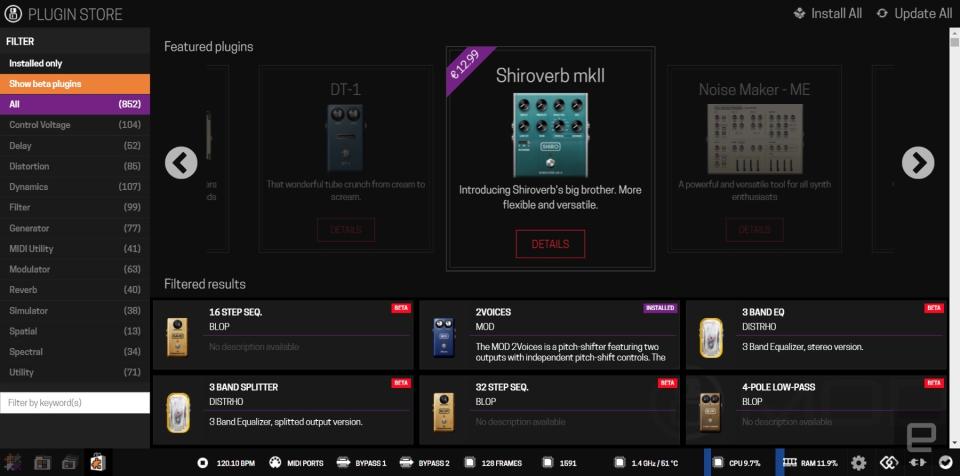MOD Duo X review: A do-it-all music box with potential
At $749 it could use a little more polish, but there's a lot to be excited about.
There’s this growing trend of musical devices that try to do it all. The Organelle. The ZOIA. The Polyend Digit / Beebo. The Mod Duo. They’re basically computers that can be effects processors, synthesizers, loopers or samplers. They all have particular strengths and weaknesses, but the pitch is the same: They’re a physical, standalone version of the sort of tools you’d normally need a computer and a DAW to take advantage of.
The MOD Duo X takes this concept (and the MOD platform) in a slightly new direction. It’s not an instrument like the Organelle. And it’s not an effects pedal like the original MOD Duo or the ZOIA. Instead, it’s a desktop device with a slew of customizable onboard controls that are primarily built for live effects manipulation. This is squarely aimed at DJs and electronic musicians. There are two endless encoders, eight potentiometers, four programmable buttons and a trio of buttons for navigating pages of parameters and recalling saved states.
That’s not to say it can’t be played like a synthesizer. Hook up a MIDI controller or program one of the several built in sequencers, and you’ve got a standalone performance instrument. It even has MIDI host capabilities, so if you’ve got a budget controller that’s USB only, you can still connect it to the MOD Duo X.

The Duo X is pretty comprehensive on the connectivity front. In addition to the USB-A port for connecting a controller or thumb drive, you’ll find:
USB-B for connecting to a computer to build your virtual pedalboards
Stereo audio in and outs (which can double as dual mono ins and outs)
An input jack for an expression pedal or control voltage (CV)
A headphone jack that can also output CV
5-pin MIDI in and out jacks
S/PDIF audio out
And an Ethernet jack for connecting MOD’s proprietary line of accessories
In general, the hardware here is impressive. And, considering the $749 price, it better be. The endless encoders spin and depress with a satisfying thunk. That said, I do wish they had a knurled texture to improve the grip. On the other hand, the knobs have a great texture but I wish they offered a little more resistance. The two screens are large and easily readable, even if the viewing angles aren’t the best. The metal package is incredibly solid and would probably break a toe if you dropped it. This is certainly a piece of road-worthy gear.
What makes the MOD Duo line truly unique, though, is its patching interface. Unlike the ZOIA which has you press color-coded buttons, or the Organelle which requires you to learn how to program in Pure Data, here you fire up a browser and connect things in a virtual pedal board. The UI is pretty intuitive, but I won’t pretend to love the look of it. Many of the virtual pedals take their visual inspiration from Boss and MXR. But the overly skeuomorphic look (they’re even set on a virtual hardwood floor) feels kinda dated.

My aesthetic preferences aside, the interface is both approachable and powerful. If you’ve ever connected one guitar pedal to another in the real world, you’ll feel right at home here. The one quirk being that your signal chain will go from left to right, even though most physical effects units are the other way around (including the MOD Duo X itself).
But, since this is all in a computer you can be a lot more flexible in your routing. You can easily stack virtual cables to create feedback loops, process your sound through parallel effects chains, or use CV to manipulate effect parameters. A simple example would be dropping an LFO in your pedal board and connect it to the rate of the harmonic tremolo effect and have it get faster and slower over time. Just know that right now, there’s no way to replace a pedal or a module with a new one while preserving its connections. So, if you build something particularly complex and want to change one part, it might be frustrating.

Now, there’s one problem: That example of interacting modules creating dynamic and interesting effects is actually a lot easier to pull off on the ZOIA in many cases. The internal CV routing features of the Duo X are relatively new and seem a little messy. While most of the synth modules work well together, it’s not immediately obvious how to get the virtual Eurorack parts to talk to the pedals and effects. Which is a shame because that’s where a lot of the power of the Mod ecosystem lies.
(For the record, you need to click “Manage CV Ports” at the top of the UI, change the name of the CV output you want to connect, then go to the settings menu of your target pedal, select the parameter you want to modulate, assign it to CV and select your newly created output from the drop-down.)
The one upside to this somewhat convoluted system is that it works even if there’s no appropriate input. So, if you want to modulate an LFO with another LFO, you can — even though the LFO module doesn’t have a CV input. Still, it’s a bit more complicated just pressing a couple buttons on the ZOIA.
It’s also worth noting that you can’t build a pedalboard or patch directly on the Mod Duo X. You’ll need to be connected to a computer. This isn’t a huge deal since the Duo X is meant to sit on your desk anyway. (When it comes time to record, definitely make sure to unplug since USB can generate quite a bit of noise in music gear.)

The onboard controls are quite useful for tweaking parameters. When you build your pedalboard in the browser-based UI you assign the controls you want. The endless encoders are perfect for navigating menus of waveforms or tempo-synced delay times. The four programmable buttons on the bottom are ideal for turning on and off effects, or controlling a looper. And the eight knobs in the middle are obviously great for changing effect parameters.
The three small buttons toward the top are the only controls with preassigned functions. The middle button cycles through pages of controls, while the other two save and recall “snapshots”. So, even though there’s only eight knobs on the front, you can actually assign up to 24 parameters to them and just swap through sets. The two large screens make sure you never get lost or confused about what knob controls what. The one limitation here is that you can’t easily create macros where a single knob controls multiple parameters simultaneously. You can hack together a solution using CV, but MOD Devices says some improved macro features are in the works.
Snapshots are saved settings for your pedalboard, and they’re particularly useful for live performances. For example, you could string together a distortion, a low-pass filter, a reverb and a delay. For the left button you could save a snapshot with the cutoff on the filter turned down, the distortion turned off and the reverb tails at a modest level, with the delay adding body. While the right button could turn on the distortion, open the filter and turn the reverb tails way up to create an epic wash of sound. And then you could bounce back and forth between those two settings. Or, you could make more subtle tweaks with the knobs and then go right back to a saved state.
Engadget · MOD Duo X sound samples
OK, so let’s get to the most important part: How does the Mod Duo X sound? Pretty good — mostly. See, underneath the rugged metal exterior is a Linux computer running LV2 audio plugins. So, the quality of individual modules and effects varies a bit based on the developer, because many of them were not created by MOD Devices, but simply ported over. We don’t need to dig into the technical details of what an LV2 plugin is. Just know that it’s basically an open source alternative to the VST plugin format used by all the major DAWs. But, it’s not nearly as widely supported, which limits the selection of plugins somewhat. I say “somewhat,” because while you won’t find effects from big names like Arturia or Native Instruments, there are well over 300 available in the MOD store. And, if you’re willing to live on the edge and enable beta plugins (some of which don’t even have an interface yet) that number balloons to over 850.

The synth modules leave something to be desired, honestly. There are some gems in here like TAL Noise Maker, AmSynth, Triceratops and the incredible DX-7 emulator Dexed (the latter two still being in beta). But, there are also a lot of SoundFont players, which are good for recreating ‘90s video game scores (and not much else).
The selection of CV-controlled synth modules is pretty limited right now, but they’re already quite capable of creating experimental textures, chest-rattling drones and basic poly synths. Plus, there are a ton more in the works. Once you enable “show beta plugins” the number of CV plugins jumps from 19 to 104, including additional oscillators and a ring modulator.
So as a virtual modular synth, the MOD platform should be getting more interesting. It’s worth mentioning that the Poly Effects Beebo also uses LV2 plugins, and it comes with a selection of ported modules from the beloved Mutable Instruments. So perhaps those will eventually make their way over to the MOD Plugin Store as well.
For the moment, though, the MOD Duo X is much better as an effects processor than as a synth. Most of the effects here are pretty good, but some are clearly better than others. The delays are mostly solid, as are many of the reverbs and modulation effects.
The various distortion, saturation and amp emulations are a little more inconsistent. The best distortions are the ones that embrace their digital side like the Infamous Hip2B and Paranoia, which are aggressive, glitchy and absolutely destroy your signal. Plugins that try to recreate classic analog gear are a little less exciting. The Big Muff emulation, for instance, isn’t bad but it sounds like a real Big Muff in the same way a Monet looks like a real sunrise.

The amp and cab models are also a bit uneven. The Marshall JCM800 emulator is pretty good, but the Rickenbacker M-16 Supersonic is underwhelming. With some careful tuning, though, the Duo X can be a solid headphone amp or direct in box for a guitar. Just be warned that the cab simulators vary pretty wildly not only in quality but in volume, too.
Those volume swings are one of the biggest annoyances with the Duo X. All other settings being the same, some cabs or pedals are whisper quiet, while others will threaten to blow out your speakers. You’ll also notice some digital clipping and artifacts with certain effects. There’s a ton of horsepower in here (a 1.4GHz 64-bit hexacore ARM CPU and 2GB of RAM) and it’s almost impossible to max out the CPU without being ridiculous, so I suspect the issues lie with those particular plugins.
It may still have some rough edges, but if you want an expansive all-in-one multi effects unit with amp simulators that you can use for direct recording or practicing with headphones, then the MOD Duo X is quite compelling. Yes, you could get a multi-effects pedal from the likes of Zoom or Digitech that also has a ton of effects and amp sims, but they can’t hold a candle to the Duo X’s flexibility, ease of programming and build quality. Plus, the live performance potential of the Duo X can’t be overstated.
If you’re more interested in creating one-of-a-kind effects than building a virtual pedalboard, the ZOIA is the better bet. Its interface is a little clunkier and doesn’t lend itself to real time manipulation, but it makes it much easier to take the individual components of an effect and connect them in new and interesting ways.
Meanwhile, if you want something that will be an instrument first and foremost, the Organelle is the way to go. It’s still among my favorite sound mangling tools and really shines as a playground for experimental sampling, sequencing and effects.
Both the ZOIA and the Organelle have larger and more active communities building unique patches. While there is a place to share pedalboards for the Duo X, right now it doesn’t seem to offer much in the way of compelling content. As MOD builds out its store and the platform matures that could change.

So where does that leave us? Well, with a very exciting and flexible device that still needs a bit of polish. The MOD Duo X has a potentially bright future and differentiates itself enough from the pack that it should have no trouble finding an audience. But it definitely needs to grow into its $749 asking price.

